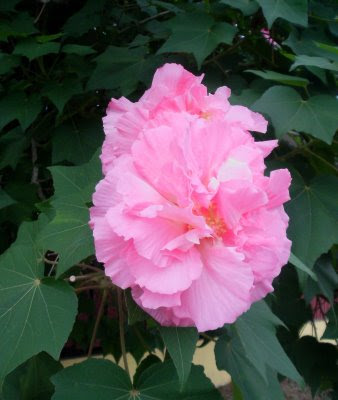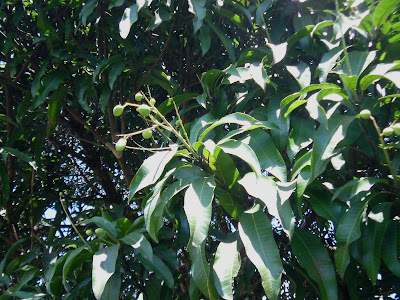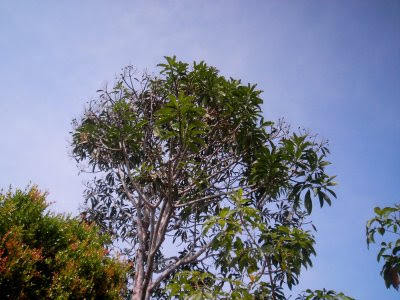 Bintulu is near the sea and its coastline faces the open South China Sea. Indeed if you are to sail straight north you would have beached at the coasts of Vietnam. The sea sprays, distinct dry weather, sandy soils and lots of monsoon rains have made the hibiscus plants here high performers. Two species that are native here are the Sea Hibiscus ( Hibiscus tiliaceus) and the Rose of Sharon ( Hibiscus mutabilis). While the Sea Hibiscus need to be planted closest to the sea or even in waters, the rose of Sharon prefers a well-drained soil. One peculiar habit common to both is the changing nature of its flowers as the day progresses. In the case of the Rose of Sharon,it starts white early in the morning and gradually develops into a dark pink as the day progresses. In like manner, the Sea Hibiscus starts the day in strong yellow and changes to orange when evening sets.
Bintulu is near the sea and its coastline faces the open South China Sea. Indeed if you are to sail straight north you would have beached at the coasts of Vietnam. The sea sprays, distinct dry weather, sandy soils and lots of monsoon rains have made the hibiscus plants here high performers. Two species that are native here are the Sea Hibiscus ( Hibiscus tiliaceus) and the Rose of Sharon ( Hibiscus mutabilis). While the Sea Hibiscus need to be planted closest to the sea or even in waters, the rose of Sharon prefers a well-drained soil. One peculiar habit common to both is the changing nature of its flowers as the day progresses. In the case of the Rose of Sharon,it starts white early in the morning and gradually develops into a dark pink as the day progresses. In like manner, the Sea Hibiscus starts the day in strong yellow and changes to orange when evening sets.
Friday, July 3, 2009
Coastal Hibiscus
 Bintulu is near the sea and its coastline faces the open South China Sea. Indeed if you are to sail straight north you would have beached at the coasts of Vietnam. The sea sprays, distinct dry weather, sandy soils and lots of monsoon rains have made the hibiscus plants here high performers. Two species that are native here are the Sea Hibiscus ( Hibiscus tiliaceus) and the Rose of Sharon ( Hibiscus mutabilis). While the Sea Hibiscus need to be planted closest to the sea or even in waters, the rose of Sharon prefers a well-drained soil. One peculiar habit common to both is the changing nature of its flowers as the day progresses. In the case of the Rose of Sharon,it starts white early in the morning and gradually develops into a dark pink as the day progresses. In like manner, the Sea Hibiscus starts the day in strong yellow and changes to orange when evening sets.
Bintulu is near the sea and its coastline faces the open South China Sea. Indeed if you are to sail straight north you would have beached at the coasts of Vietnam. The sea sprays, distinct dry weather, sandy soils and lots of monsoon rains have made the hibiscus plants here high performers. Two species that are native here are the Sea Hibiscus ( Hibiscus tiliaceus) and the Rose of Sharon ( Hibiscus mutabilis). While the Sea Hibiscus need to be planted closest to the sea or even in waters, the rose of Sharon prefers a well-drained soil. One peculiar habit common to both is the changing nature of its flowers as the day progresses. In the case of the Rose of Sharon,it starts white early in the morning and gradually develops into a dark pink as the day progresses. In like manner, the Sea Hibiscus starts the day in strong yellow and changes to orange when evening sets.
Thursday, July 2, 2009
Delicious local fruits
 The month of June is special for the abundance of the local Malay Apple fruits called " Jambu Bol". I love these fruits for two reasons. First when half-ripe they are best taken with soy sauce or shrimp paste ( the famed Bintulu 'Belacan') as salad. Secondly when sufficiently ripe they are sweet tasting and soft to eat. When eating them do not remove the red skin covering, just like eating normal apples. But remember there is a sizable seed inside that gets removed easily. From the ripe seeds you can propagate the tree easily.
The month of June is special for the abundance of the local Malay Apple fruits called " Jambu Bol". I love these fruits for two reasons. First when half-ripe they are best taken with soy sauce or shrimp paste ( the famed Bintulu 'Belacan') as salad. Secondly when sufficiently ripe they are sweet tasting and soft to eat. When eating them do not remove the red skin covering, just like eating normal apples. But remember there is a sizable seed inside that gets removed easily. From the ripe seeds you can propagate the tree easily. This is my special favourite in Bintulu. Being close to the coast, you can get any amount of fresh coconuts at Bintulu's tamu or jungle produce market which is located somewhere in the center of Bintulu town. After drinking the juice I would normally eat the flesh which is very soft and sweet too. Here you eat it with a 'spoon' made out a wedge from the coconut skin. Hmm... does the job of scooping the flesh splendidly. A piece of coconut like above fetches for Rm1.50 .
This is my special favourite in Bintulu. Being close to the coast, you can get any amount of fresh coconuts at Bintulu's tamu or jungle produce market which is located somewhere in the center of Bintulu town. After drinking the juice I would normally eat the flesh which is very soft and sweet too. Here you eat it with a 'spoon' made out a wedge from the coconut skin. Hmm... does the job of scooping the flesh splendidly. A piece of coconut like above fetches for Rm1.50 .
Labels:
Fruits of Bintulu,
Jambu Bol,
Malay apple tree
Friday, June 26, 2009
A Hard Day's Work

Yesterday I spent the day harvesting some ripe oil palm fruits at my eco-farm. Most fruit bunches are still small because the trees are barely two the half years old. At the picture ( inset) the cross section of the fruit shows a thick yellowish pulp, a thin shell containing a white fleshy core . Presently the average diameter of the fruit is 2.5-3.0 cm. which is considered still small. High quality oils are derived from the fruit pulp and the kernel of the seed.
 Notice how close to the ground the fruiting heads are. The variety of oil palm planted here are of the Elaeis guineensis, GH 500 series. In Malaysia the oil palm parents here originated from Africa. Thus sometimes the oil palm Elaies guineensis is called African Oil Palm. Oil palm trees thrives in Bintulu due due its tropical climate,ideal soil type and hilly topography. Once established oil palm trees are hardy and will bear fruit for the next 20 - 25 years. I would say my pension lies in the trees.
Notice how close to the ground the fruiting heads are. The variety of oil palm planted here are of the Elaeis guineensis, GH 500 series. In Malaysia the oil palm parents here originated from Africa. Thus sometimes the oil palm Elaies guineensis is called African Oil Palm. Oil palm trees thrives in Bintulu due due its tropical climate,ideal soil type and hilly topography. Once established oil palm trees are hardy and will bear fruit for the next 20 - 25 years. I would say my pension lies in the trees. Yesterday's harvest totalled 120 kilos. The present market price for fresh fruit bunches is RM 350 per tonne. By the trend of things, next month I would be able to harvest about 200 kilos. Such is oil palm farming, you need to have patience to accumulate enough quantities to sell the to the millers.
Yesterday's harvest totalled 120 kilos. The present market price for fresh fruit bunches is RM 350 per tonne. By the trend of things, next month I would be able to harvest about 200 kilos. Such is oil palm farming, you need to have patience to accumulate enough quantities to sell the to the millers.
Labels:
Elaies guineensis,
Fresh Fruit Bunches,
Oil Palm
A Tree Much Wanting in Bintulu
 It surprises me why this lovely tree is not planted all over Bintulu. I saw this stand at Medan Raya shopping area today. The Coral Tree ( Erythrina) has brilliant scarlet flowers that stay long on the tree. As such it is a useful tree to grow in areas where you want to see colours everyday. Having not seen one for a while now especially one that is flowering, I took a lot of close up shots of its flowers. A few are shown here. Notice the bean-like pods that contain ripe seeds below.
It surprises me why this lovely tree is not planted all over Bintulu. I saw this stand at Medan Raya shopping area today. The Coral Tree ( Erythrina) has brilliant scarlet flowers that stay long on the tree. As such it is a useful tree to grow in areas where you want to see colours everyday. Having not seen one for a while now especially one that is flowering, I took a lot of close up shots of its flowers. A few are shown here. Notice the bean-like pods that contain ripe seeds below.
 If you are to visit most hotels and resorts this tree is usually seen in their landscaping design. I guess most landscapers love its red bunchy flowers that envelop the tree. Further I think choice is determined by its growth characteristics. It is slow growing and suitable for places near water bodies where you can watch the dark green leaves and flowers touch the water surface and reflecting its brilliant colours. We need more such trees in Bintulu.
If you are to visit most hotels and resorts this tree is usually seen in their landscaping design. I guess most landscapers love its red bunchy flowers that envelop the tree. Further I think choice is determined by its growth characteristics. It is slow growing and suitable for places near water bodies where you can watch the dark green leaves and flowers touch the water surface and reflecting its brilliant colours. We need more such trees in Bintulu.Thursday, June 25, 2009
Bintulu Fishes
 Soon I'll be missing all the fresh fishes of Bintulu. That's because I'll be on my way to Kuching this coming Monday. Bintulu is a haven for fresh seafood. There's hardly any good fish market in Kuching City that is even 50% of what Bintulu is. Anyway this afternoon I dropped by at the fish market along the Sebiew River which is greatly patronised by fish lovers here.
Soon I'll be missing all the fresh fishes of Bintulu. That's because I'll be on my way to Kuching this coming Monday. Bintulu is a haven for fresh seafood. There's hardly any good fish market in Kuching City that is even 50% of what Bintulu is. Anyway this afternoon I dropped by at the fish market along the Sebiew River which is greatly patronised by fish lovers here.
Wednesday, June 24, 2009
Grasshopper in Emperor's Clothes
 I had an excellent half-morning workout at the farm just now. Top on the agenda was to thin the Lengkuas shrub for propagation purpose. Indeed from two big shrubs I managed to plant another 5 very well established clumps. Lengkuas ( Alpinia galanga) are useful plant to grow for its rhizomes. In traditional medicine the rhizomes are considered a aphrodisiac. However I take it as an appetiser and the young shoots can be taken as salad. And goes without saying, you need to eat it with the famed Bintulu belacan!. There are also grown commercially for the rhizomes that are processed into capsules to counter sea sickness.
I had an excellent half-morning workout at the farm just now. Top on the agenda was to thin the Lengkuas shrub for propagation purpose. Indeed from two big shrubs I managed to plant another 5 very well established clumps. Lengkuas ( Alpinia galanga) are useful plant to grow for its rhizomes. In traditional medicine the rhizomes are considered a aphrodisiac. However I take it as an appetiser and the young shoots can be taken as salad. And goes without saying, you need to eat it with the famed Bintulu belacan!. There are also grown commercially for the rhizomes that are processed into capsules to counter sea sickness. Then while I was thinning a section of the vegetation island of the Heliconia Valley I came across a unique phenomena. My eyes were caught by a slight movement among the leaves of the Cempedak ( Artocarpus integer). A grasshopper in camouflage. Yes this is the first time I came across at the farm a grasshopper that has its wings resembling the Cempedak leaves. Thus I had a field day photographing this unique natural phenomena. Below is the grasshopper posing for today's show.
Sunset at the Farm
 Though the closest beach is about 25 km away from the farm, we do have the chance to enjoy the beautiful sunset from the farm looking west. Over the distant hills and about 25 km straight on is the Tg.Batu Beach where the best sunset can be watched in Bintulu. Well today I'm blessed with a Bintulu sunset as I finished the day at the farm.
Though the closest beach is about 25 km away from the farm, we do have the chance to enjoy the beautiful sunset from the farm looking west. Over the distant hills and about 25 km straight on is the Tg.Batu Beach where the best sunset can be watched in Bintulu. Well today I'm blessed with a Bintulu sunset as I finished the day at the farm.
Sunday, June 21, 2009
Sweet tasting , sweet tasting...
 This morning my taste buds turned wild. I harvested two ripe fruits of the Terap ( Artocarpus odoratissimus Blanco). They came from a tree I planted about three years ago and thus there were not many fruits on the tree just yet. Among the Melanaus of Bintulu the fruit is also called 'Ong Lumok'. And the joke is if you're somewhat bald -headed don't feel offended if someone call you 'Ong Lumok' . The thick soft skin has soft hair-like spikes that are nice to caress. The white fleshy part of the fruit is very sweet . The ripe fruit is very soft and it needs a slight turn of the palm to open it up.
This morning my taste buds turned wild. I harvested two ripe fruits of the Terap ( Artocarpus odoratissimus Blanco). They came from a tree I planted about three years ago and thus there were not many fruits on the tree just yet. Among the Melanaus of Bintulu the fruit is also called 'Ong Lumok'. And the joke is if you're somewhat bald -headed don't feel offended if someone call you 'Ong Lumok' . The thick soft skin has soft hair-like spikes that are nice to caress. The white fleshy part of the fruit is very sweet . The ripe fruit is very soft and it needs a slight turn of the palm to open it up.
Saturday, June 20, 2009
The Mango Tree
 This is the only Mango Tree standing at the Bintulu Town centre. I grew up with this tree because it was planted not far from the government quarters where our family stayed in the 1960's. Where the tree is located was about the farthest end of the government quarters area at that material time. All older buildings built in and around 1960's are gone. Thus the Mango Tree is the only reminder of the old Bintulu . It is my fervent hope that this will tree will be preserved for posterity.
This is the only Mango Tree standing at the Bintulu Town centre. I grew up with this tree because it was planted not far from the government quarters where our family stayed in the 1960's. Where the tree is located was about the farthest end of the government quarters area at that material time. All older buildings built in and around 1960's are gone. Thus the Mango Tree is the only reminder of the old Bintulu . It is my fervent hope that this will tree will be preserved for posterity.On the left is a picture I took of the tree when its was flowering heavily in April this year. The picture below shows the tree bearing tiny fruits. Unfortunately just weeks ago I notice that someone had cut a main branch of the tree to collect the fruits and as a result damaged much of its beautiful form.
Thursday, June 18, 2009
Shrubby Dillenia ( Dillenia suffruticosa)
 Feeling slightly better today, I decided to have a walk around the farm. The rashes that developed over my body slowly disappeared and my body temperature has subsided and returned to normal. According to the good doctor I was suffering from a viral infection which is self-eliminating. Feeling upbeat, I took shots of the Shrubby Dillenia or what we call here as 'Simpoh Air' ( Dillenia suffruticosa) that grows abundantly at my farm. The 'Simpoh Air' is indeed a suitable tree to plant along streams and near houses.
Feeling slightly better today, I decided to have a walk around the farm. The rashes that developed over my body slowly disappeared and my body temperature has subsided and returned to normal. According to the good doctor I was suffering from a viral infection which is self-eliminating. Feeling upbeat, I took shots of the Shrubby Dillenia or what we call here as 'Simpoh Air' ( Dillenia suffruticosa) that grows abundantly at my farm. The 'Simpoh Air' is indeed a suitable tree to plant along streams and near houses.
Ong Balem
 When I arrived at my farm last week, I noticed the huge 'Balem' tree ( Mangifera pajang) bearing tiny fruits at the very tips of the branches. This is the first time I see the tree producing fruits. This tree could have been here for about 50 years now judging from its height and size. It's indeed very difficult to see them in the wild these days because forests keep on disappearing. In the picture (inset) is a close up of the Balem fruit with its thick skin peeled. To eat it you need to slice the flesh into small pieces.
When I arrived at my farm last week, I noticed the huge 'Balem' tree ( Mangifera pajang) bearing tiny fruits at the very tips of the branches. This is the first time I see the tree producing fruits. This tree could have been here for about 50 years now judging from its height and size. It's indeed very difficult to see them in the wild these days because forests keep on disappearing. In the picture (inset) is a close up of the Balem fruit with its thick skin peeled. To eat it you need to slice the flesh into small pieces.
Tuesday, June 16, 2009
A Day by the Beach
 It has been a while since I have not update any pictures here. The reason is that I was very busy in Kuching for the last month. However I'm back and wish to make up for lost time. Since I arrived Bintulu on the 7th of June I fell ill and just felt better today. There again, my computer got into problems because of a faulty power pin which needed replacement parts from outside Bintulu. That problem got solved by late afternoon. Before I picked up the notebook, I went to see Pantai Temasya or the Tanjung Batu Beach, just 10 minutes drive from Bintulu Town centre. I thought by spending an afternoon by the beach would help me further recuperate from my illness which was caused by a fall when I climbed the slopes to gather some fruits last Friday at the farm. Well all's well that ends well. Below are pictures that I took at Pantai Temasya ( Temasya Beach, Tg. Batu)
It has been a while since I have not update any pictures here. The reason is that I was very busy in Kuching for the last month. However I'm back and wish to make up for lost time. Since I arrived Bintulu on the 7th of June I fell ill and just felt better today. There again, my computer got into problems because of a faulty power pin which needed replacement parts from outside Bintulu. That problem got solved by late afternoon. Before I picked up the notebook, I went to see Pantai Temasya or the Tanjung Batu Beach, just 10 minutes drive from Bintulu Town centre. I thought by spending an afternoon by the beach would help me further recuperate from my illness which was caused by a fall when I climbed the slopes to gather some fruits last Friday at the farm. Well all's well that ends well. Below are pictures that I took at Pantai Temasya ( Temasya Beach, Tg. Batu)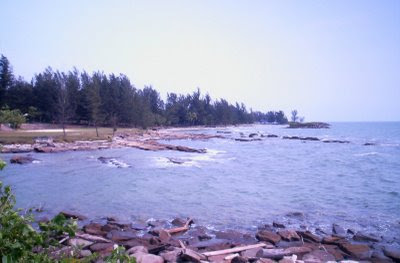
View of Pantai Temasya shoreline from the northern point of the beach.

Tall Carpentaria Palms ( Carpentaria acuminata) line up this footpath at the lush greenery environment within the beach landscaped areas.
 This is where all cars that enter the beach area make their turns. The park at the Temasya Beach is richly planted with trees. Here tall casuarina trees ( Casuarina equisitifolia) dwarf the coconut palms below.
This is where all cars that enter the beach area make their turns. The park at the Temasya Beach is richly planted with trees. Here tall casuarina trees ( Casuarina equisitifolia) dwarf the coconut palms below.Monday, May 4, 2009
Bintulu in Yellow Flames
It has been a week since I've been back in Bintulu where the weather has been very dry, sunny and hot. I guess this distinct dry weather has stimulated the Yellow Flame trees here to flower gregariously. That was the scene when I went around the town today.

Lines of Yellow Flame ( Peltophorum pterocarpum) trees that were mainly planted about 20 years ago were in full flower. Yellow Flame trees are tall, some reaching 20 m high. They are ideal for roadsides because of their spreading crown which provide much shade and beauty . The Yellow Flame tree is native to Malaysia and that means Bintulu too. Sometimes locals call them ' Batai Laut'. They love the coastal areas and are somewhat deciduous in habit. New shoots begin to develop about a week after the leaves have fallen.
 The inflorescence's are terminal on the new shoots and are panicles of large, bright yellow flowers.
The inflorescence's are terminal on the new shoots and are panicles of large, bright yellow flowers.
 They are fast growing but can also be grown as an instant tree if you wish to enjoy its shade and beauty sooner. These trees are better planted in big open spaces and I don't encourage it to be planted in residential premises for the main reason that its adventurous roots can choke up underground services. They are easily grown from seeds. I understand that the bark of the tree can be used to make dye by batik makers especially on the Indonesian island of Java.
They are fast growing but can also be grown as an instant tree if you wish to enjoy its shade and beauty sooner. These trees are better planted in big open spaces and I don't encourage it to be planted in residential premises for the main reason that its adventurous roots can choke up underground services. They are easily grown from seeds. I understand that the bark of the tree can be used to make dye by batik makers especially on the Indonesian island of Java.

Lines of Yellow Flame ( Peltophorum pterocarpum) trees that were mainly planted about 20 years ago were in full flower. Yellow Flame trees are tall, some reaching 20 m high. They are ideal for roadsides because of their spreading crown which provide much shade and beauty . The Yellow Flame tree is native to Malaysia and that means Bintulu too. Sometimes locals call them ' Batai Laut'. They love the coastal areas and are somewhat deciduous in habit. New shoots begin to develop about a week after the leaves have fallen.
 The inflorescence's are terminal on the new shoots and are panicles of large, bright yellow flowers.
The inflorescence's are terminal on the new shoots and are panicles of large, bright yellow flowers. They are fast growing but can also be grown as an instant tree if you wish to enjoy its shade and beauty sooner. These trees are better planted in big open spaces and I don't encourage it to be planted in residential premises for the main reason that its adventurous roots can choke up underground services. They are easily grown from seeds. I understand that the bark of the tree can be used to make dye by batik makers especially on the Indonesian island of Java.
They are fast growing but can also be grown as an instant tree if you wish to enjoy its shade and beauty sooner. These trees are better planted in big open spaces and I don't encourage it to be planted in residential premises for the main reason that its adventurous roots can choke up underground services. They are easily grown from seeds. I understand that the bark of the tree can be used to make dye by batik makers especially on the Indonesian island of Java.Saturday, April 4, 2009
Licuala Palm ( Licuala spinosa)
 Walking below the jungle canopy behind my chalet, I checked on my collection of the Licuala Palm.Licualas are important for the locals here because the leaves are used to thatch sleeping mats, sun hats or to wrap food. They are native to Borneo and therefore Bintulu.
Walking below the jungle canopy behind my chalet, I checked on my collection of the Licuala Palm.Licualas are important for the locals here because the leaves are used to thatch sleeping mats, sun hats or to wrap food. They are native to Borneo and therefore Bintulu. Licualas can reach 4 meters high. The leaves are borne from a long stalk. The Licuala stem is very short and mostly hidden in the thick humus rich environment of the tropical rain forest like ours here. They prefer filtered light and do not grow well in a potty environment. I've tried many times to grow them in pots but to utter failure. The best policy would then be to leave them in peace on the jungle floor where they truly belong.
Licualas can reach 4 meters high. The leaves are borne from a long stalk. The Licuala stem is very short and mostly hidden in the thick humus rich environment of the tropical rain forest like ours here. They prefer filtered light and do not grow well in a potty environment. I've tried many times to grow them in pots but to utter failure. The best policy would then be to leave them in peace on the jungle floor where they truly belong.Call to Prayer

The Bintulu mosque, Masjid Daerah Bintulu - circa 1920
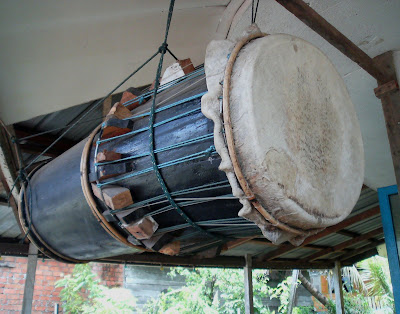 Yesterday I went to Masjid Daerah Bintulu to perform my Friday prayers. After that I took pictures of the 'Beduk' which is a big drum made of wood and goatskin. In the good old days, the drum would be sounded five times a day to call Muslim to prayers. Nowadays, people use loudspeakers and microphone to amplify the call to prayers or 'Azan' over the PA system.
Yesterday I went to Masjid Daerah Bintulu to perform my Friday prayers. After that I took pictures of the 'Beduk' which is a big drum made of wood and goatskin. In the good old days, the drum would be sounded five times a day to call Muslim to prayers. Nowadays, people use loudspeakers and microphone to amplify the call to prayers or 'Azan' over the PA system. Observe the very top picture. On both towers is faintly shown the 'Beduk' which is the same as above. As a young kid I used to climb the tower and hit the 'Beduk' in successive drumming and tempo at the point of 'Azan' to indicate prayer time. It is my fervent hope that this instrument will forever be kept as a historical relic by the Bintulu mosque authority.
Observe the very top picture. On both towers is faintly shown the 'Beduk' which is the same as above. As a young kid I used to climb the tower and hit the 'Beduk' in successive drumming and tempo at the point of 'Azan' to indicate prayer time. It is my fervent hope that this instrument will forever be kept as a historical relic by the Bintulu mosque authority.
Labels:
Azan,
Drum,
Friday Prayers,
Masjid Daerah Bintulu
Thursday, April 2, 2009
Menara Kidurong
 Here's another view of the iconic building belonging to the Bintulu Port Authority. Called the 'Menara Kidurong', it is designed in the form of a huge ship. Bintulu Port Authority undertakes the operation of the Bintulu Port through another sister company called the Bintulu Port Sdn Bhd.
Here's another view of the iconic building belonging to the Bintulu Port Authority. Called the 'Menara Kidurong', it is designed in the form of a huge ship. Bintulu Port Authority undertakes the operation of the Bintulu Port through another sister company called the Bintulu Port Sdn Bhd.Tuesday, March 31, 2009
Traveller's Palm ( Ravenala madagascariensis)
 I guess Bintulu will need to plant more of these 'palms'. Called the Traveller's Palm ( Ravenala madagascariensis ) there are a delight to see as a distant. Looking like a huge fan, they look tempting to travellers as if waving them to come and stop by . Such icon would be good for Bintulu's tourism. Strictly speaking, these are not 'palms'. They belong to the banana family. However its palm-like in habit i.e. having a single trunk and a crown of leaves that is one-sided and making a symmetrical fan-shaped pattern. The above picture is taken at my eco-farm in Bintulu.
I guess Bintulu will need to plant more of these 'palms'. Called the Traveller's Palm ( Ravenala madagascariensis ) there are a delight to see as a distant. Looking like a huge fan, they look tempting to travellers as if waving them to come and stop by . Such icon would be good for Bintulu's tourism. Strictly speaking, these are not 'palms'. They belong to the banana family. However its palm-like in habit i.e. having a single trunk and a crown of leaves that is one-sided and making a symmetrical fan-shaped pattern. The above picture is taken at my eco-farm in Bintulu.
Subscribe to:
Posts (Atom)


